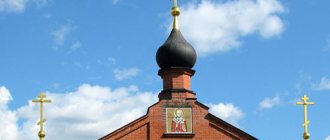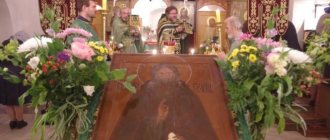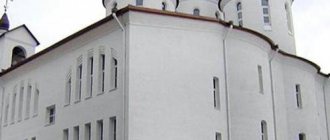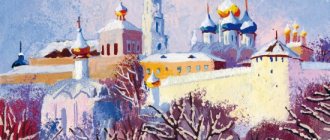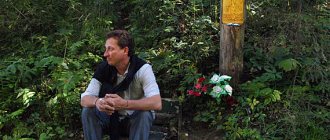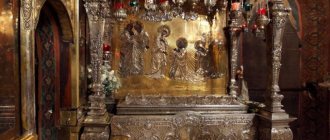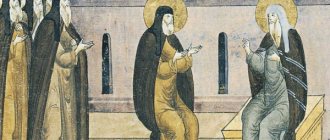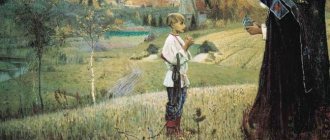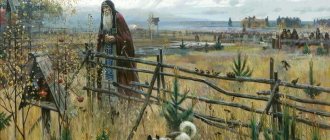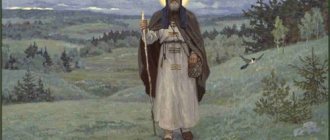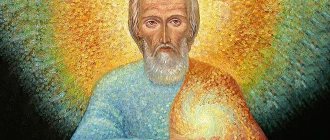| Church of St. Sergius of Radonezh in Rogozhskaya Sloboda | |
| A country | Russia |
| City | Moscow |
| Year of foundation | 1365 |
| Website | sergeyrad.ru |
| Abbot | Archpriest Valentin Vasilievich Radugin |
In 1365, Metropolitan Alexy brought from Constantinople the Image of the Savior Not Made by Hands. With this the Ecumenical Patriarch blessed him for the Russian Metropolis. During the voyage, a terrible storm broke out, threatening the death of all passengers on the ship.
The storm subsided on August 16, the Feast of the Image of the Savior Not Made by Hands. In honor of this miracle, the Metropolitan gave St. Sergius the blessing to found a monastery in the name of the Savior and send his disciple Andronik to establish the Spassky Monastery, where the Church of St. Sergius was later built.
The first parishioners of the Church of St. Sergius of Radonezh in Rogozhskaya Sloboda were coachmen
The Church of St. Sergius of Radonezh stands on Nikoloyamskaya Street. It got its name from the “St. Nicholas on the Pits” temple located on it. In ancient times, postal stations that had resting places for coachmen with inns and stables were called pits.
In 1595, Tsar Boris Godunov ordered such postal stations to be installed at all Moscow outposts.
Sovereign Tsar and Grand Duke of All Rus' Boris Fedorovich Godunov. Image from the Tsar's title book. 1672 Tsar Boris Godunov ordered in 1592 to establish postal stations at all Moscow outposts. Horses and coachmen were supplied to them by residents of the Rogozhskaya (Yamskaya) settlement
The settlement itself was called Rogozhka or Rogozhskaya Yamskaya settlement. It arose near the village of Andronikha on the left bank of the Yauza. Those coachmen who were engaged in “yam racing” or delivering horses for transporting mail settled here.
In addition, they transported goods from Moscow to the village of Stary Rogozhsky Yam, in Soviet times - the city of Noginsk, Moscow region.
The Temple of St. Sergius of Radonezh is the suburban church of the Rogozhskaya Yamskaya Sloboda.
Yamshchitskaya (Yamskaya or Gonnaya) Rogozhskaya settlement was located along the Vladimirsky tract (Vladimirskaya road, or Vladimirka) - the modern Enthusiasts highway. In 1506, a postal station called Old Rogozhsky Yam (Rogozhskaya Yamskaya) was established here, the first on the Moscow-Vladimir-Nizhny Novgorod-Kazan road.
Moreover, starting from the 18th century, not only coachmen began to settle in the area of Rogozhskaya Sloboda.
Modern view of the former Rogozhskaya (Yamskaya) settlement from the air. In the foreground is the Temple of Sergius of Radonezh. The temple of St. Sergius was considered the suburban temple of Rogozhskaya (Yamskaya) settlement
Usually each settlement had its own church. That is why, opposite the Church of St. Sergius, the Church of St. Alexius, founded at the beginning of the 17th century, is located. The first parishioners of the Sergius Church were the coachmen living next to it.
At the same time, in the 1740s, Gonnaya lost its status as a settlement due to changes in the customs border of Moscow, and newcomers began to actively settle there.
The first wooden church in the Rogozhskaya Yamskaya settlement was built in 1642 or 1697
The first wooden church of St. Sergius was built in the settlement in 1642 or 1642 by the coachmen who lived there. It became her parish church of the settlement. Over time, this Church of the Holy Trinity with the chapel of St. Nicholas began to be called the Church of St. Nicholas, in Yamy, or on Yam.
It was she who gave the name to the street on which in our time the Church of St. Sergius of Radonezh (the Life-Giving Trinity) stands in Rogozhskaya Sloboda.
Aerial photography of the Andronikov Monastery in Moscow (Russia). The Church of St. Sergius of Radonezh (Trinity of Life-Giving) in Rogozhskaya Sloboda received this name because the Spaso-Andronikov Monastery is located not far from it. His first abbot was the beloved disciple of St. Sergius of Radonezh - Andronik
The wooden church was replaced by a stone temple in 1722. Its main altar was consecrated in honor of the Holy Trinity. In Moscow at that time there were many churches called Trinity. That is why they decided to name this temple in honor of St. Sergius of Radonezh.
The choice of this name for the church was also because the Spaso-Andronikov Monastery is located nearby, the first abbot of which was the beloved disciple of St. Sergius of Radonezh - Andronik.
1722
this year a stone temple was built in Rogozhskaya Yamskaya Sloboda
Urban legends say that the Temple of St. Sergius of Radonezh (the Life-Giving Trinity) in Rogozhskaya Sloboda in ancient times was considered one of the centers of Old Believers in Moscow.
This is due to the fact that after the plague of 1771, fans of the old faith were allocated burial places for fellow believers in the churchyard of the Sergius Church. Since then, Old Believers began to settle in the vicinity of the cemetery, while they visited only their Old Believer churches.
Rogozhskoe cemetery. After the plague epidemic of 1771, the Old Believers were allowed to bury their fellow believers, including in the graveyard of the Church of St. Sergius in Rogozhskaya Sloboda. Since then, it began to be considered one of the centers of the Old Believers in Moscow, although it was never an Old Believer
There is a pillar next to the temple to this day. It was installed in 1783. There is an inscription carved on it: “Two miles from Moscow.” This is how our ancestors counted distances.
How to get there by car
By car you can approach the church by moving along Ryazansky Prospekt in the direction from the city center. Before reaching the Ryazansky Prospect metro station 700 m, you need to turn right onto Okskaya Street. After 350 m there will be a temple on the right side.
While moving along Ryazanka, you can pass the metro station and turn right at the roundabout: onto Academician Scriabin Street. At the next intersection also turn right onto 1st Novokuznetskaya Street and follow it to the Gennady Chekhachev Theater. After 200 m, turn right onto Okskaya Street. The intersection is located next to the church, it will be on the right side.
When driving from the center of Moscow along Volgogradsky Prospect, after the Kuzminki metro station, turn left onto Zelenodolskaya Street, move along it until it intersects with Fedora Poletaev Street, turn left at the intersection and go straight to Okskaya Street. It is located after 1 intersection, you should turn right at it, the temple is located on the left side at a distance of 250 m from the intersection.
Different parts of the Church of St. Sergius of Radonezh in Rogozhskaya Sloboda were built at different times
Parts of the Church of St. Sergius of Radonezh in Rogozhskaya Sloboda were built at different times. This phenomenon is typical for all Moscow churches. At the same time, its most ancient part is considered to be the refectory, to which the chapels of St. Sergius of Radonezh and St. Nicholas are attached.
The refectory was built in 1796, and it was part of the previous stone church of St. Sergius of Radonezh, which was robbed by Napoleonic troops and burned down in 1812.
The refectory of the Church of Sergius of Radonezh, in Rogozhskaya Sloboda, in Moscow. The refectory of the Church of St. Sergius was erected in 1796 and it is recognized by scientists as its most ancient part
The heavily damaged temple needed reconstruction, but parishioners and clergy managed to save some of the utensils by burying them in the ground. In addition to the Sergius Church, almost the entire Nikoloyamskaya Street burned down in the Moscow fire of 1812.
Later it was rebuilt with stone two-story houses. The current church building was built in 1818.
1818
this year St. Sergius Church acquired a deep blue color of the walls
It was then that the church acquired its traditional deep blue color. Funds for the restoration of the temple were collected among its parishioners, with the main contribution made by G.P. Smolensky.
The state councilor, who held the position of church warden, spent almost all of his fortune on this good cause.
A drawing from the 1840s shows an old hipped bell tower. In 1864 it was replaced with a new three-tier
The temple acquired its final appearance after the architect F.M. Shestakov reconstructions in 1834-1838. According to his project, in particular, the ceremonial five-domed church that exists in our time was built. This happened after the fire of 1835.
This fact is confirmed by the red brickwork in the basement of the summer (main) church with hallmarks known in the early 19th century. manufacturer Balashev. The modern three-tier bell tower was built in 1864 to replace the previous hipped one.
XXI Century
The Church of St. Sergius entered the new millennium with a recreated bell tower. The decision to restore it was made at the beginning of 2000. I. V. Konovalov, senior bell ringer of the Moscow Kremlin and the Cathedral of Christ the Savior, chairman of the Society of Church Bell Ringers, worked on the resumption of ringing. The project was carried out using stereophotogrammetry using a photograph from Naydenov’s album. The method made it possible to restore the dimensions and shape of the bell tower with an accuracy of several centimeters. The entire selection of bells has also been recreated - from one hundred poods to eight kilograms: 100, 50, 25, 15, 8, 4, 2, 1 and 0.5 poods. Upon completion of the work on December 15, 2001, a cross with four banners was installed on the bell tower.
The first ringing of the stopudovo bell took place at the all-night vigil on Epiphany in 2002. Bells weighing 50 and 25 pounds were made and delivered to the temple in the spring of 2002. On April 5, 2002, the consecration of the bells in the bell tower took place. The first ringing of all the bells sounded on Annunciation 2002.
In 2010, Archpriest Alexander Abramov was appointed rector of the temple. In the same year, a small consecration of the chapel of All Saints, who shone in the Russian land, took place. Scientific restoration of the appearance of the temple and its shrines has begun (and continues). In 2013, the Serafimovsky chapel received new decoration: the painting of the altar part was done by Irina Zaron, the altar barrier was done by Sergei Antonov. In 2014, work was completed on rehanging the bells and gilding the heads of the bell tower and the temple.
In 1916 the temple flourished
Before the revolutionary events in 1916, the temple flourished. So his staff included: two priests, three deacons, three psalm-readers and three prosphora servers. The total income of the temple was more than 20,000 rubles.
Temple of St. Sergius of Radonezh, 1883. Until 1917, before the revolutionary events, the Church of St. Sergius in Rogozhskaya Sloboda flourished
At the temple there were houses of clergy and clergy, and iron-covered shops operated. A special building was built to hold disputes with the Old Believers.
It was furnished in the old style to facilitate the return of schismatics to the fold of the Church. The cost of the building amounted to more than 40,000 rubles.
In Soviet times, the Sergius Church was given over to a warehouse, and the icons were chopped with an ax and burned
During Soviet times, the Church of St. Sergius of Radonezh in Rogozhskaya Sloboda did not escape the fate of other Moscow Orthodox churches. At first the authorities did not touch it, but in 1922 they seized 5 pounds 30 pounds of silver church valuables and utensils from it.
To do this, the vestments were “torn off” from the icons and all church decoration was examined for the presence of valuables in their composition.
Priest, regent and composer V.N. Zinoviev. Despite the persecution of Orthodoxy by the Soviet authorities, until 1938 the Church of St. Sergius of Radonezh in Rogozhskaya Sloboda did not close. Thus, in 1924-1925, the famous church composer Vasily Nikolaevich Zinoviev served as the choir director here.
At the same time, church life in the temple continued. The fact that for some time in the 1920s it was considered Renovationist played a role. In the same 1922, the miraculous Chernigov-Gethsemane Icon of the Mother of God was transferred to it from the closed Gethsemane monastery of the Trinity-Sergius Lavra.
It was in the temple until its closure, after which it was kept in a private collection. In 1924-1925, the famous church composer and teacher, priest V. N. Zinoviev, served as the choir director.
1938
this year the Church of St. Sergius of Radonezh was closed
The Church of St. Sergius was closed in 1938. Just before the closure of the church, the parishioners and clergy managed to save some ancient icons. For example, we managed to remove the miraculous image of the Mother of God “Quench My Sorrows,” which is now in the Church of St. Nicholas in Kuznetsy.
Currently, a list of it is kept in the St. Sergius Church. The remaining icons, furnishings and books were chopped up with an ax and burned.
Icon of the Mother of God “Quiet my sorrows.” In 1938, the icon was rescued from the Church of St. Sergius just before its closure. Currently it is in the Church of St. Nicholas in Kuznetsy
The church building itself was closed, despite the fact that most Moscow churches in Soviet times were simply blown up or demolished. Subsequently, it, like other premises of the temple complex, was used as workshops and a warehouse. Communal apartments were placed in the clergy house.
Pilgrim[edit]
Schedule of services:
On Saturday - Divine Liturgy at 8.00. On Sundays, as well as on the days of the twelve and great holidays - Divine Liturgy at 9.30, on the eve of the All-Night Vigil at 17.00.
On Friday at 17.00 there is an akathist at the Miraculous Kiysk Cross (except for the days of Great Lent and All-Night Vigils of holidays). Passions and all services to the Cross are performed at the Miraculous Kiysk Cross.
On days of especially revered saints and icons of the Mother of God - Matins and Divine Liturgy at 8.00.
Schedule of services for the month
Before the transfer to the Russian Orthodox Church, the Church of St. Sergius was practically not monitored
During Soviet times, the closed temple was poorly maintained: it was practically not looked after. Thus, eyewitnesses claim that small trees grew on the domes of the church, and deep cracks covered its walls. All the crosses were removed from the domes and the gilding was stripped off. At the end of the 1950s, the remnants of the old coatings were removed and painted iron was installed instead.
Church of St. Sergius of Radonezh (Life-Giving Trinity) in Rogozhskaya Sloboda. 1979 During the years of Soviet power, the temple fell into disrepair, as it was not repaired or looked after.
There were no crosses on the temple until 1984. As for the clergyman, he did not escape repression. For example, in the fall of 1937, the rector of the church, Hieromartyr Peter Nikotin, and the singer, martyr Nikolai Kuzmin, were arrested. Later they were shot at the notorious Butovo training ground.
In 1984, the sculpture workshop of the Art Fund was located in the main room of the temple. In 1985, the temple was transferred as a branch to the Central State Museum of Ancient Russian Culture and Art named after Andrei Rublev.
December 4, 1991
The Church of St. Sergius of Radonezh in Rogozhskaya Sloboda was transferred to the Russian Orthodox Church
The museum was located in the Spaso-Andronnikov Monastery. They decided to arrange an exhibition of ancient Russian church art in the building.
In 1990, the building of St. Sergius Church was restored. After a while it was transferred to the Russian Orthodox Church. On December 4, 1991, the temple was consecrated by Bishop of Solnechnogorsk Sergius (Fomin).
